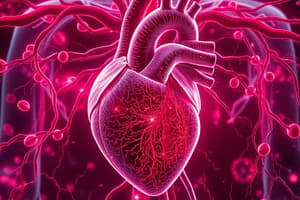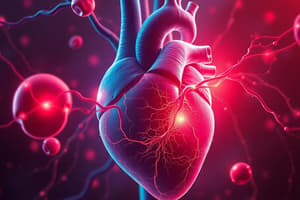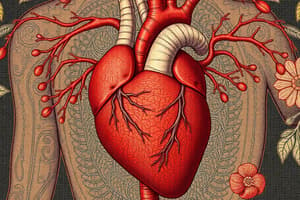Podcast
Questions and Answers
What is the main function of the cardiovascular system?
What is the main function of the cardiovascular system?
- To provide the body with essential oxygen and nutrients
- To remove waste from the body
- To circulate blood throughout the body
- All of the above (correct)
How many chambers does the heart have?
How many chambers does the heart have?
- 5
- 2
- 4 (correct)
- 3
What is the purpose of the semilunar valves in the heart?
What is the purpose of the semilunar valves in the heart?
- To regulate the flow of blood through the heart
- To allow blood to move from the atria to the ventricles
- To push blood out of the heart into the systemic and pulmonary circulatory systems (correct)
- To prevent backflow of blood from the ventricles to the atria
What is the primary function of blood vessels?
What is the primary function of blood vessels?
What is the pathway of oxygen-rich blood in the body?
What is the pathway of oxygen-rich blood in the body?
What is the main function of blood in the human body?
What is the main function of blood in the human body?
What is the role of capillaries in the cardiovascular system?
What is the role of capillaries in the cardiovascular system?
Which blood vessels are thicker and more elastic to accommodate high pressure?
Which blood vessels are thicker and more elastic to accommodate high pressure?
Where does oxygen diffuse into cells from during cellular respiration?
Where does oxygen diffuse into cells from during cellular respiration?
Which component of blood is essential for cellular respiration?
Which component of blood is essential for cellular respiration?
What is the primary function of arteries in the cardiovascular system?
What is the primary function of arteries in the cardiovascular system?
Where do nutrients absorbed from food in the digestive system travel before being distributed to the rest of the body?
Where do nutrients absorbed from food in the digestive system travel before being distributed to the rest of the body?
Flashcards are hidden until you start studying
Study Notes
Cardiovascular System
Heart Function
The cardiovascular system is responsible for providing the body with essential oxygen and nutrients while removing waste. The core component of the cardiovascular system is the heart, which serves as a muscular pump that distributes blood throughout the body. The heart is composed of four chambers: the left and right atria (upper chambers), and the left and right ventricles (lower chambers). During a typical heartbeat (cardiac cycle), the heart goes through two stages: diastole (relaxation) and systole (contraction). The cardiac cycle is initiated when the aortic and pulmonary valves close, allowing blood to move into the left and right atria, respectively. Subsequently, the tricuspid and mitral valves open, enabling blood to pass from the atria to the respective ventricles. Finally, the semilunar valves open, pushing blood out of the heart into the systemic and pulmonary circulatory systems.
Blood Composition
Blood plays a critical role in maintaining the overall functionality of the human body. It transports oxygen, nutrients, waste products, and circulating elements to various tissues and organs. The three types of blood vessels involved in this process are arteries, veins, and capillaries.
Oxygen Transport
Oxygen-rich blood returns to the heart from the lungs, passing through the pulmonary veins into the left atrium and then into the left ventricle. From there, it is pumped through the aorta into the systemic circulatory system, which includes arteries, arterioles, and capillaries. Once the blood reaches the tissues, oxygen diffuses across the capillary walls and into the surrounding cells, serving as a vital component in cellular respiration.
Nutrient Transport
In addition to oxygen, blood carries various nutrients to the body's tissues. Many of these nutrients are absorbed from food in the digestive system and travel through the bloodstream to the liver for processing before being distributed to the rest of the body.
Blood Vessels Structure
Blood vessels play a crucial role in the cardiovascular system by facilitating the transport of blood throughout the body. The structure of blood vessels enables them to perform their functions efficiently:
Arteries
Arteries are blood vessels that carry blood away from the heart. They can be further divided into large and small arteries, with larger arteries receiving the highest pressure of blood flow and being thicker and more elastic to accommodate the high pressures.
Capillaries
Capillaries are tiny blood vessels that branch off from arteries and are a single-cell layer thick. They provide the exchange sites for nutrients, gases, and waste products between the bloodstream and the surrounding tissues.
Veins
Veins transport blood back to the heart. They contain valves to prevent the backflow of blood and facilitate the upward movement of blood against gravity.
Conclusion
In summary, the cardiovascular system is a complex network of organs and vessels that work together to deliver oxygen, nutrients, and waste products to the body's tissues. The heart, blood vessels, and blood are the primary components of this system, and they work together to ensure the proper functioning of all organ systems in the body. Proper maintenance of the cardiovascular system through a healthy diet, regular exercise, and maintaining optimal blood pressure and cholesterol levels is essential for overall health and well-being.
Studying That Suits You
Use AI to generate personalized quizzes and flashcards to suit your learning preferences.




